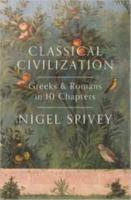
Head of Zeus (2015) h/b £14.88 346pp 9781781855003
Here is a glorious book—it quite simply reignites one’s passion for the classical world and, from a personal point of view, it reminded the reviewer why she spent the last twenty-one years teaching Greek and Latin in schools. S. writes beautiful prose yet with no hint of pomposity or grandeur. As with his other books, and as clearly shown in his BBC series ‘How Art Made the World’, he is a natural and passionate communicator.
The structure is fresh. No chronological romp from the Minoans to the fall of the Roman Empire here, but instead ten chapters for ten key cities which all had a crucial role to play in the development of classical civilisation. There is a logical progression from Troy (chapter 1) to Constantinople (chapter 10), with an unexpected visit to Utopia in the middle where the focus is upon classical philosophy. The journey around the Mediterranean covers history, philosophy and literature but, despite no illustrations beyond a few maps, is also hugely visual with many vivid references to architecture, sculpture and archaeology (as one would expect, given S.’s background). Chapters on Athens, Sparta and Rome relate the great stories of the battle of Marathon, the Spartans at Thermopylae and Hannibal, but there are also countless less well-known vignettes.
In the chapter on Ephesus, for example, S. takes the reader from the magnificent buildings there to the bleak, undeveloped landscape of the Antonine Wall. This might at first sight seem contrived, enabling the author to tick off another place in the Roman Empire, but his argument is that the Romans did not simply head into territories such as Britain to procure goods and raw materials but also to spread their national identity. One way of doing the latter was to build roads and aqueducts and leave Rome’s mark on the infrastructure.
In the book’s last chapter, S. tellingly ends with a line about the Emperor Constantine: ‘He was the last emperor to be deified as a god and the first to be worshipped as a saint’. In this sentence is contained the author’s contention that the Roman Empire did not, as the great 18th century historian Gibbon would have us believe, fall; rather it reinvented itself in the form of a new Rome in the East from where its values, now combined with those of a Middle Eastern religion, continued to exist and to have great influence over Western and Arab culture. The classical world, we are reminded by this lively and enjoyable survey, is very far from dead.
Hannah Murray—OXLAT Latin Teaching Scheme Instructor
